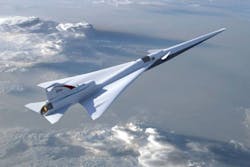NASA ‘Son of Concorde’ is now being manufactured by Lockheed Martin
"The start of manufacturing on the project marks a great leap forward for the X-59 and the future of quiet supersonic commercial travel," said Peter Iosifidis, Low Boom Flight Demonstrator program manager Lockheed Martin Skunk Works. "The long, slender design of the aircraft is the key to achieving a low sonic boom. As we enter into the manufacturing phase, the aircraft structure begins to take shape, bringing us one step closer to enabling supersonic travel for passengers around the world."
Related: New York-to-London in 3 ½ hours? Boeing wants to bring supersonic air travel back
Since the final voyage of the legendary Conchord from London to New York near the dawn of the twenty-first century, supersonic passenger travel has been a fading memory. Soon, it could be back with a boom – or, rather, a “thump” – thanks to the Low Boom Flight Demonstrator which will allow the X-59 QueSST (Quiet Supersonic Transport) aircraft to break the sound barrier while producing a sound equivalent to a car door closing – a 75 Perceived Level decibel (PLdB).
NASA’s been working for decades essentially on looking at technologies to take the boom out of ‘sonic boom.’ We want a sonic ‘thump’ or a sonic ‘sound,’” said NASA commercial supersonic technology project manager Peter Coen. “And the idea is to design the airplane so that the shockwaves that are generated in supersonic flight are arraigned in a way that you have a gradual pressure rise which produces a quiet sound. Ultimately (we want) to prove that the sound that’s created is acceptable to people on the ground.”
Related: Virgin Galactic test supersonic, rocket-powered VSS Unity commercial spacecraft
The X-59 is scheduled for delivery by the end of 2021. Once the aircraft has finally been constructed and its noise credentials established, NASA says it’ll carry out test flights over other US cities and gather intelligence from the ground.
Learn more: search the Aerospace & Defense Buyer's Guide for companies, new products, press releases, and videos
About the Author
Jamie Whitney
Senior Editor
Jamie Whitney joined the staff of Military & Aerospace Electronics in 2018 and oversees editorial content and produces news and features for Military & Aerospace Electronics, attends industry events, produces Webcasts, and oversees print production of Military & Aerospace Electronics.
